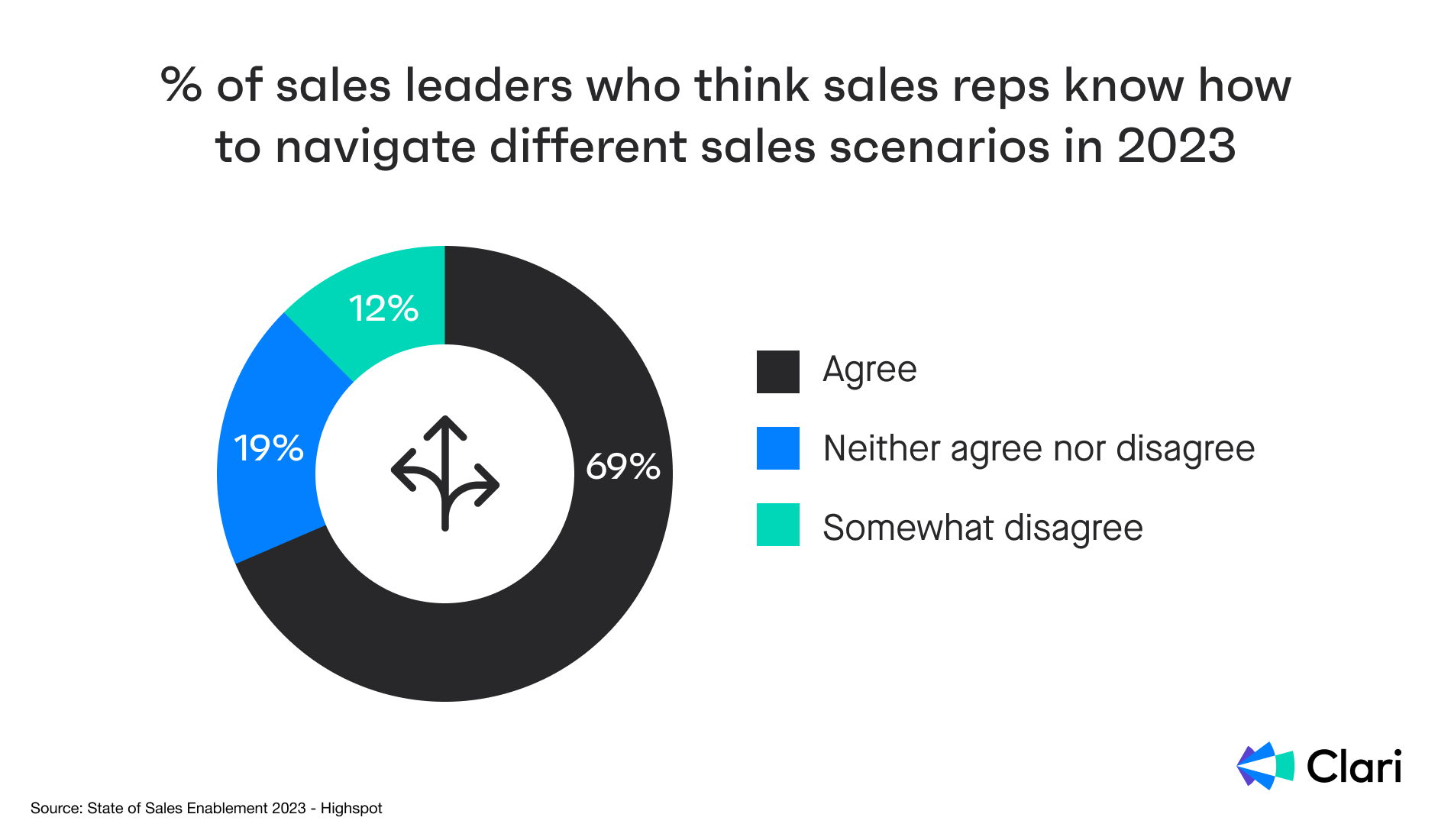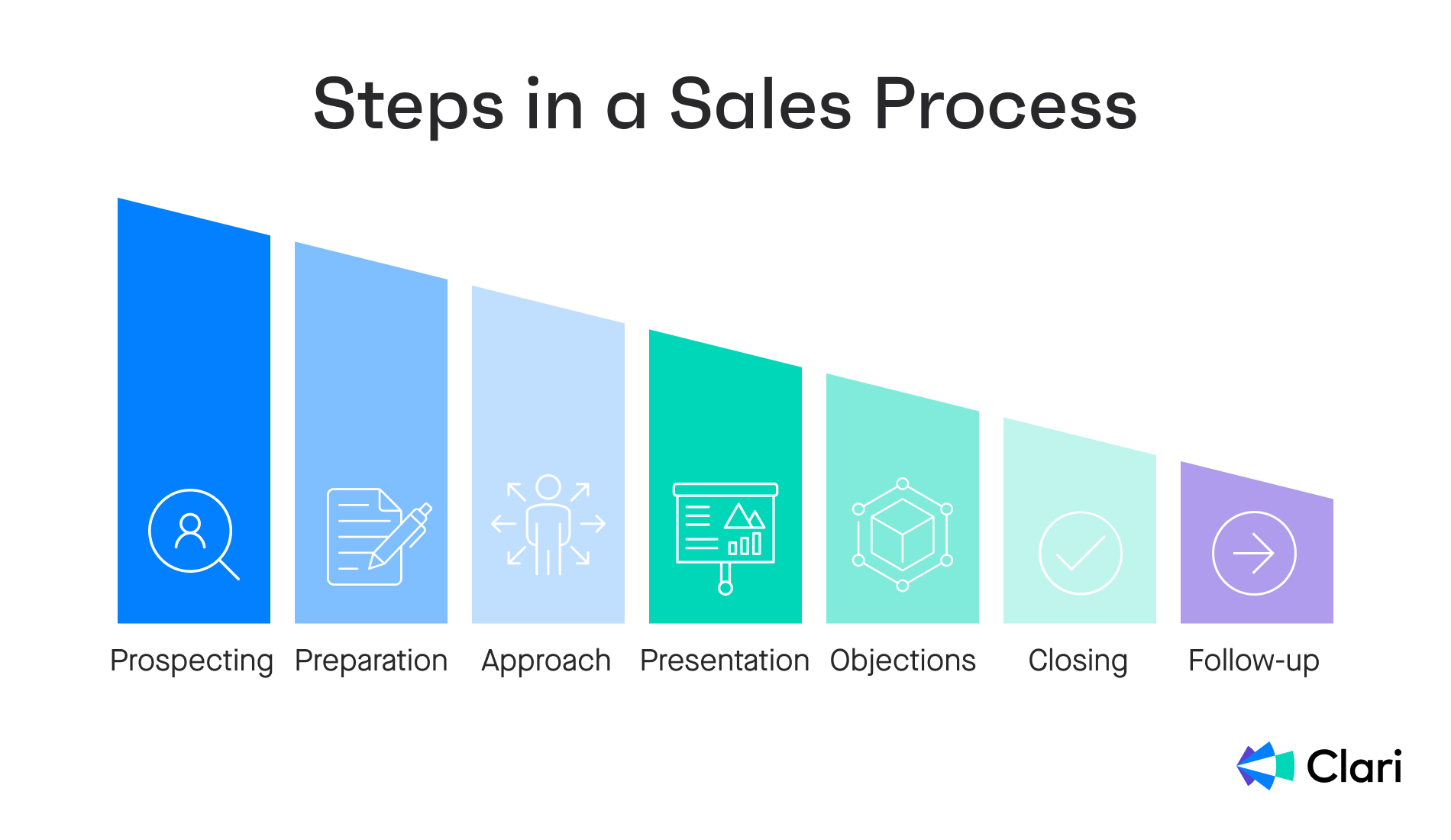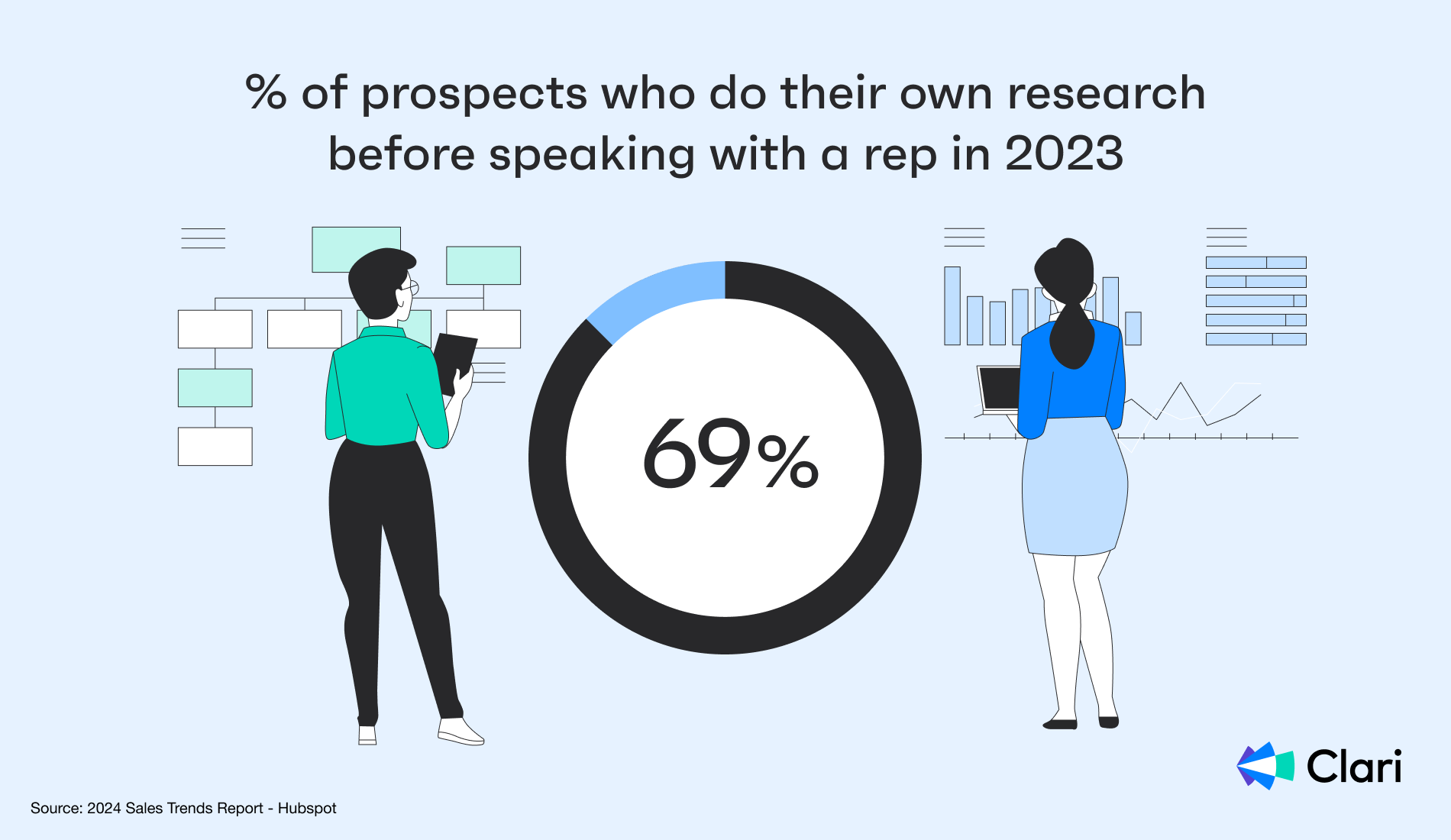Whether you’re a business owner, sales manager, or sales rep, you need to understand the steps in the sales process.
If you skip or undervalue a step, it will directly affect how many deals you close. A prospect may stall and lose interest in your product or feel rushed and start to disengage.
If you struggle to move leads through the customer journey, mastering each sales process step will help.
In this article, we’ll explore each sales process step in detail, offer best practices, and share how you can create a unique sales process for your business.
Table of Content:
- What is the sales process?
- Why does the sales process matter?
- The 7 steps of the sales process
- The sales process is unique to each business
- What’s next?
What is the sales process?
A sales process is a series of steps you develop to help your sales reps find and engage prospects and gradually turn them into customers. A typical sales process includes prospecting, preparation, approach, presentation, handling objections, and closing.
Outlining the sales journey this way makes it easier to train reps and boost performance. While experienced sales professionals know it by heart, newer reps often struggle with certain stages.
Not sure about the difference between a sales process and methodology? Think of the sales process as the mountain leading towards your goal, the sale, while sales methodologies are the different paths you can navigate.
Why does the sales process matter?
A formalized sales process helps your reps follow logical steps to nurture and convert as many leads as possible into customers.
According to a sales enablement survey by Highspot, only 69% of sales leaders trusted their reps to know how to navigate different sales scenarios.

Plus, this was a general statement for all reps. How confident would they feel in new reps? How confident do you feel?
You are probably quite confident if you have ironed out a thorough sales process and sales playbook for your company. You are likely not very confident if you have no formal sales process.
The process you go through with each lead will depend on your industry and prospective customers. That makes it crucial to understand before you settle on a specific sales method. If you don’t understand the topography of the mountain, how can you decide which path to take?
That makes understanding the different steps in a sales process so important. They outline a general roadmap for how your reps should handle each stage of a sale. It’s the foundation for teaching new reps how to sell effectively.
The 7 steps of the sales process
In general, you can divide a sales process into seven clear steps:
- Prospecting: You identify potential customers and lay the groundwork for reaching out to them later.
- Preparation (Qualification): You research these prospects and make sure they need and can pay for your product.
- Approach (Demonstration): You first reach out to vetted prospects, using what you know about them/their company to build a relationship.
- Presentation (Evaluation): You showcase how your product can deliver value to the lead.
- Handling objections (Negotiation): You listen to your prospect’s concerns and help alleviate them.
- Closing: You get the potential buyer to sign on the dotted line.
- Follow-up (Nurturing): Account executives follow up with new customers to ensure they’re happy.
 Below, we explore these stages in more detail, including tips for improving them.
Below, we explore these stages in more detail, including tips for improving them.
1. Prospecting
Prospecting is the step in identifying and researching potential prospects. Prospects are likely potential customers for your products or services. (In sales teams with sales development representatives (SDRs), initial outreach also happens at this stage.)
One way to find good prospects is to develop buyer personas—profiles that outline the characteristics of companies that likely need your product and the relevant roles within those companies. (Make sure you include these in your sales playbook).
Once you have defined your needs, your sales reps can start researching. Here are a few concrete tips to improve your prospecting:
Pro tips:
- Use sales tools to explore firmographic data and find companies that are a good fit. Use your buyer profiles to identify key people in the company.
- Check for any potential connections or previous touchpoints with your company. Perhaps a sales rep went to school with a potential champion. Or maybe an engineer has already used your product at another company.
- Qualify leads that your marketing team generates with lead generation efforts. Double-check that marketing-qualified leads are worth calling.
There’s much more to cover at this stage, so we’ve created the Prospecting Academy. It teaches you everything you need about prospecting—from identification and relationship-building to outreach—for free.
2. Preparation
Preparation is where you research and get to know the prospects selected in step one.
The last thing you want is for sales reps to randomly call prospects with zero research. They’ll ask questions irrelevant to the prospect’s needs and ruin your chances of building a relationship.
Preparation also helps you avoid wasting time on discovery calls that won’t lead anywhere, as you can qualify prospects. You turn a long list of potential leads into a shorter list of sales-qualified leads to pursue.
Pro tips:
- Ensure prospects are a good fit by checking if they’re using competitors, company size, and other indicators. You want to reach out to your ideal customers, not every relevant company on Earth.
- Lay the groundwork for successful outreach. For example, building a trusted profile on LinkedIn that showcases expertise in the industry.
- Use LinkedIn or other channels to build relationships with key decision-makers in target companies before direct outreach.
According to HubSpot’s 2024 Sales Trends report, 96% of prospects do their own research. They check various companies' features, pricing, and case studies before reaching out.

That, more than ever, makes it important to build relationships. And the sales professionals agree. In the same report, 82% of sales managers and reps said relationships were the most important part of selling in 2023.
The best way to build relationships is to start by understanding your prospect. So do thorough research.
3. Approach
During the approach stage, you finally reach out to your prospects individually. And we mean one by one. Don’t try to mass-email your list of prospects.
In B2B sales, there’s no easier way to alienate a potential customer than by sending a generic outreach email sequence. Just think of how many emails the average business leader gets every day. You don’t want to add spam to that pile.
DGR’s 2023 B2B Buyer’s Survey showed that 57% of B2B buyers preferred sales reps who used highly customized outreach.
Pro tips:
- Do not rush to the approach stage. Some inexperienced reps virtually skip the other sales process steps. That’s a recipe for failure. Ensure your reps spend enough time researching before outreach.
- Don’t send the same blanket cold email to every prospect. Personalize the headline and message to address each prospect’s unique needs. It’s not just an effective email marketing tactic but a requisite for not ruining potential customer relationships.
- Optimize your messaging approach by trying a variety of angles (but do not spam one person).
- Use cold calling sparingly. But if other channels prove ineffective, and prospect research shows they’re a good match, cold calls are a powerful weapon.
- Another effective strategy is using warm calls after interactions on LinkedIn or other channels.
- Gradually track what works and include it in your sales process playbook.
Messaging is important, and you need to get it right. However, the research and credibility-building you did in the previous steps will make the biggest difference in response rates. It doesn’t matter how good a sales email is if the client doesn’t need your product or trust you.
4. Presentation
This is the step where you showcase the value your specific product can deliver. What this looks like depends on your industry, market, and product. But often, your sales rep jumps on a call with the prospect and showcases a product demo.
Again, a tailored sales pitch is key. You should focus on the prospect’s needs, not just go on a general rant about how good your product is. DGR’s 2023 B2B Buyer’s Survey showed that 67% of B2B buyers choose a vendor because they “demonstrated a stronger knowledge of their company and needs.”
Pro tips:
- Tailor the sales presentation to each prospect’s needs. Highlight features that can help them solve business problems and case studies that align with buyer preferences.
- Modern buyers do a lot of their own research. So, don’t get too caught up in surface-level functionality. Ask open-ended questions that guide the conversation toward finding an ideal solution for the prospect.
- Avoid pushy sales tactics and focusing too much on qualification. Trust the process and your research—focus on building a relationship. Sales calls should feel about the prospect, not your rep getting their commission.
- Determine who needs to be involved in a buying decision and work to get them on board.
Related: Defining and Improving Your Sales Cycle Stages for Every Deal
5. Handling objections
In this step, you handle common customer objections during or after a sales call or demonstration.

Handling objections is an art and a difficult process. You need to foresee potential objections and address them in your training materials to give your reps a fighting chance.
Pro tips:
- Cover common sales objections and how to overcome them in your sales playbook and scripts.
- Teach reps to act in a consultative role—work through objections and potential issues together. Empathy and active listening are key. First, verbally confirm their issues to make sure that you understand. Then, suggest potential solutions.
- Use social proof, like case studies or customer testimonials, to alleviate unfounded concerns. The more relevant they are to the prospect, the better.
6. Closing
Closing is where you get the prospect to sign the deal and become a customer. As you reach the end of the sales funnel, there’s the most potential for things to go wrong.
Pro tips:
- Make sure you involve the right people in the process, decision-makers with the authority to close a deal.
- Include the champion in the closing process—they have the strongest incentive to move forward.
- Make the champion and decision-makers feel heard—address implementation concerns with concrete action steps.
- Justify the cost by quantifying how much your prospect will save or how it will impact their productivity.
- Regularly follow up and adjust your approach based on how the prospect responds to prevent revenue leak.
- In a B2B sales cycle, closing can take months, so don’t give up prematurely.
Related: 3-Step Process to Accelerate Your Path to Close
7. Follow up
Closing isn’t the final stage of sales process management—you still need to follow up. During this sales process stage, you check on the new customer to ensure their needs are met.
An effective sales process doesn’t stop when the deal is signed. Low churn rates are vital for revenue growth. It doesn’t matter if your sales pipeline is full or you’re always closing if your customers don’t stay.
Pro tips:
- Show that your company is dedicated to keeping them happy.
- Earn loyalty by avoiding potential issues, thus increasing customer lifetime value.
The sales process is unique to each business
There’s no standard way to handle the sales process that will work for every business. The necessary sales stages (and where you should focus your efforts) depend on how developed the market is, how recognized the brand is, and other factors.
What works for a SaaS company’s B2B sales team won’t work for a car dealership.
So, tailoring the sales process to your needs and industry is important. Here are a few things you can do to adapt your sales process and upgrade your sales playbook:
- Explore how your best sales reps handle the process (where they spend the most time, etc.)
- Analyze and explore your sales performance data for patterns and adjust your recommendations and sales training accordingly.
- Use sales process mapping to create a sales process flowchart that represents best practices.

There’s no universal best way to turn prospects into customers—you have to develop your own. Gradually improve your sales strategy and implementation to transform your current sales process into one that works well.
Doing so will transform the efficiency of every rep throughout your sales organization.
What’s next?
Optimizing your sales process and how your sales reps get through it is much easier with access to concrete insights.
Clari gives you access to a wide range of reports, from sales pipeline efficiency analysis to measuring the sales impact of specific actions.
Plus, it can help your reps in the approach and presentation stage by indicating high-value accounts or deals at risk of being lost.
Ready to transform how your sales teams close deals? Sign up for a demo to see Clari in action.


